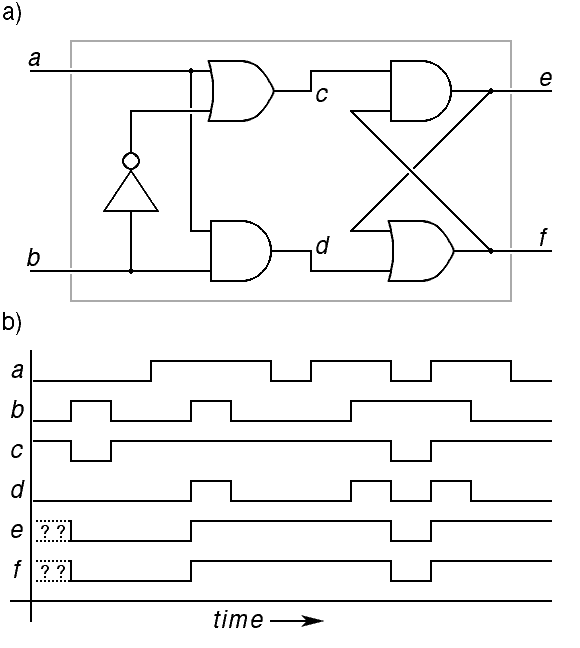inputs: a and b
outputs: e and f
intermediate values: c and d
c = a + b
d = ab
e = cf
f = d + e
a) Draw the logic circuit in schematic form with the inputs on the left and outputs on the right. (0.5 points)
b)
Draw a timing diagram for this circuit showing how the outputs change
as the inputs move through the following sequence of 13 changes:
(0.5 points)
[a,b]
= [0,0],[0,1],[0,0],[1,0],[1,1],[1,0],[0,0],[1,0],[1,1],[0,1],[1,1],[1,0],[0,0]

The topology of the diagram given for part a only appears natural after answering part c, realizing that it is an RS flipflop of some kind, and then redrawing it with the logic gates arranged as they are in an RS latch. First attempts to answer part a would typically be topologically equivalent to the answer given, but with different layouts.
c) Is this circuit a kind of flipflop? If so, what input combination causes it to remember a value, how do you set it, and how do you reset it?
Yes. To set the outputs e and f to one, put a one on the a input and apply a positive pulse to the b input. To reset the outputs e and f to zero, put a zero on the a input and apply a positive pulse to the b input.
In effect, this is a type D latch, with a as the data input, b as the clock input, e as the Q output, and f as an inverted Q output, which is to say, e and f will tend to stay identical, except during the set and reset operations, at which time they may differ briefly.
An obvious way to deal with such errors is to raise an exception when the interpreter discovers something irregular. It would be easy, for example, to check, before outputting a character, to see if the x and y coordinates are on the screen, and raise an exception if not.
a) Where should the handler be? (0.5 points)
In the main program, or in whatever code calls the code to interpret strings in this language.
b) What would you check for, and where in the code, to detect unbalanced parentheses as illustrated above? Hint: There is no need to count the parentheses. (0.5 points)
If you use an explicit stack for begin and end paren, you can check that the stack pointer is zero when you hit a null and make sure it never goes negative. In effect, the stack pointer is the parenthesis pointer.
If you use recursion to handle parentheses, you can check to see how string terminates. If the first call to the interpreter terminates with an end paren, there were too many end parens. If a recursive call terminates with a null, there were too many begin parens.
A Problem: Suggest a way to compact the code for raising exceptions by putting most of the code in one place with just one or two instructions that must be duplicated in each place the exception is raised. Your code might take one or two extra instructions to raise an exception, but it should be more compact if there are enough exceptions raised in the program. (0.5 points)
First, put this code somewhere:
RAISE_EXCEPTION: LOAD R2,R1,EXAR ; AR = exception.exar LOAD R1,R1,EXHAND JUMPS R1 ; PC = exception.exhandNow, wherever you want to raise a constraint error exception, put this code:
LIL R1,CONSTRAINT_ERROR JUMP RAISE_EXCEPTIONOr if there are many constraint error and stack overflow exceptions being raised, in many parts of the program, put this code somewhere:
RAISE_CONSTRAINT_ERROR: LIL R1,CONSTRAINT_ERROR BR RAISE_EXCEPTION RAISE_STACK_OVERFLOW: LIL R1,STACK_OVERFLOW RAISE_EXCEPTION: LOAD R2,R1,EXAR ; AR = exception.exar LOAD R1,R1,EXHAND JUMPS R1 ; PC = exception.exhandNow, to raise a constraint error, you just use:
JUMP RAISE_CONSTRAINT_ERROR